Europe is dropping €13 million on AI visionaries who promise anyone—even your uncle who thinks Blender makes milkshakes—can whip up 3D models with casual text prompts like “wizard tower made of pizza.” Wild, yes, but let’s pump the brakes: these tools can pump out surreal castles, yet realism and quality frequently miss the mark. Training data is slim, creative outputs can get weirdly uncanny, and legal issues lurk around every polygon. Curious what else could go sideways?
Buckle up, digital dreamers—the AI-powered 3D modeling revolution isn’t just knocking on the industry’s door, it’s already snooping through the keyhole and rearranging the furniture.
The AI 3D modeling wave isn’t waiting for an invitation—it’s already inside, redecorating the digital landscape.
With a €13 million investment now fueling Europe’s AI visionaries, the promise is clear: more people, less sweat, and a universe of 3D models conjured by a few clever keystrokes. But let’s not roll out the red carpet just yet.
Sure, *text-to-model* magic makes it feel like anyone can play 3D artist. Type “medieval castle made of cheese,” and voilà, a digital dairy fortress appears.
But peer closer: details often dissolve into mush, textures look like someone painted with a potato, and mesh quality leaves a lot to be desired. Realism? Often MIA. Coherence? Sometimes lost in translation. The lack of large 3D datasets means that training next-gen models is still hamstrung by limited examples and variety.
—
Consider the trade-offs:
- User-friendly tools lower the barrier, but industry-level polish still needs human hands.
- Non-experts can leap in, but there’s a learning curve that can feel like a climb up Everest—in Crocs.
- API integration and scalability sound slick, yet quality control is a constant game of whack-a-mole.
- The 3D mapping and modeling market is expected to nearly double by 2029, promising major implications for how these trade-offs evolve.
—
And don’t get too comfy: AI models are as good as their data, and 3D datasets aren’t exactly raining from the cloud.
Training these digital beasts eats up time, money, and enough GPU cycles to make your electric bill cry. Plus, one fuzzy prompt and your “sports car” turns into a mutant roller skate.
AI-generated art tools are already creating surreal images for marketing campaigns, suggesting a future where 3D modeling follows the same evolutionary path.
—
Creativity? Still a team sport. AI spits out functional, sometimes bland, models—think IKEA furniture, not bespoke Italian design.
Human oversight is the secret sauce for nuance and flair. Overreliance risks a creative desert, and let’s not even start on algorithmic bias or legal headaches over IP.







